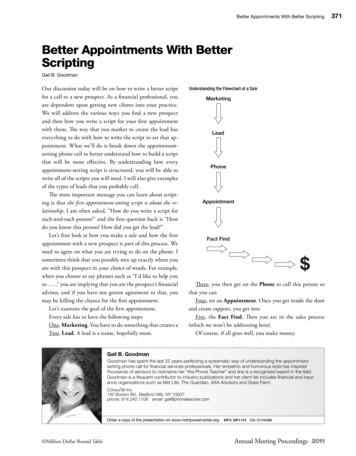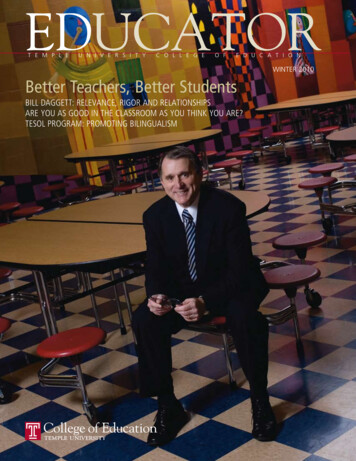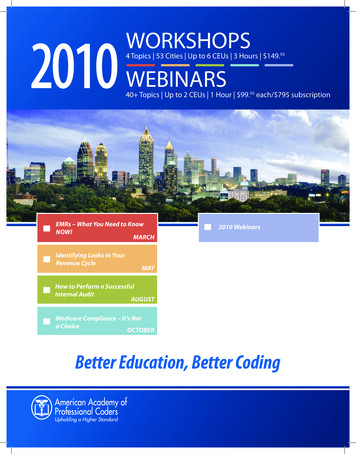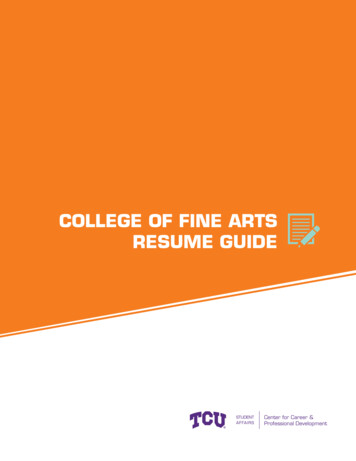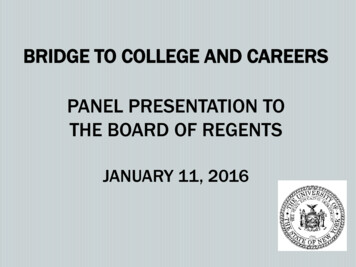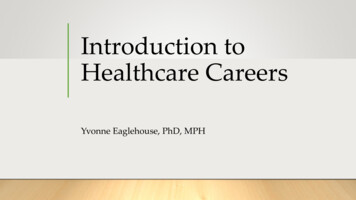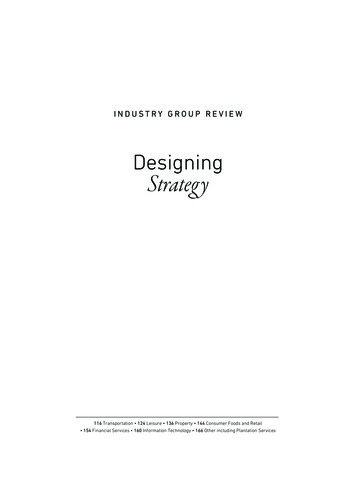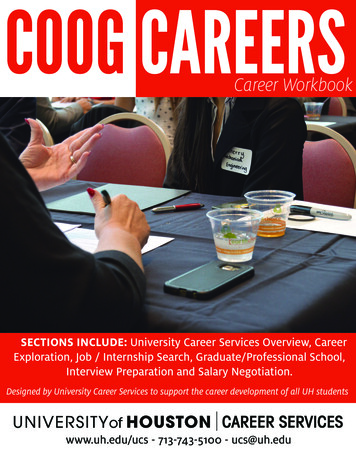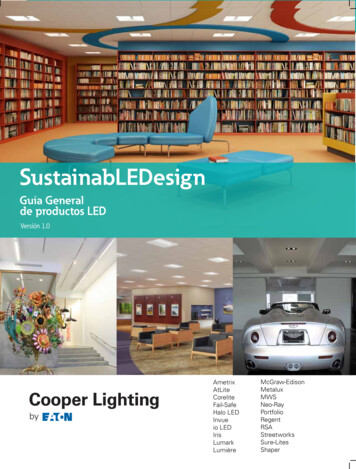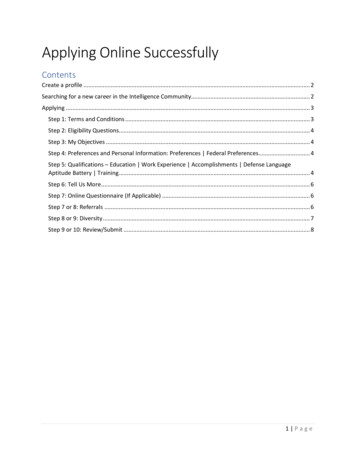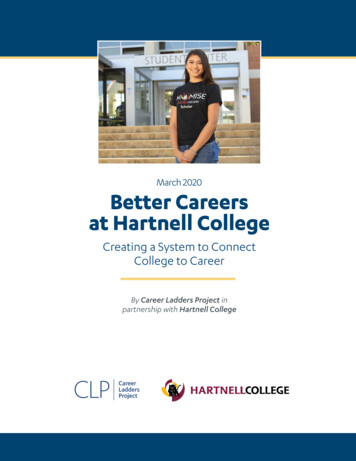
Transcription
March 2020Better Careersat Hartnell CollegeCreating a System to ConnectCollege to CareerBy Career Ladders Project inpartnership with Hartnell CollegeCareerLaddersProject
AcknowledgmentsHartnell College is the heart of the Salinas Valley. Hartnell students, many of them farm workers,become plant scientists, teachers, and tech entrepreneurs. The Hartnell approach is as welcoming asthe delicious strawberries grown in nearby fields. Career Ladders Project learned together with theirdedicated faculty and staff, and for that we are grateful.We would like to thank the Superintendent/President Dr. Patricia Hsieh and the Hartnell CommunityCollege Governing Board: Manuel M. Osorio, District 1; Aurelio Salazar, Jr. Board President, District2; Patricia Donohue, Vice President, District 3; Irma C. Lopez, District 4; Ray Montemayor, District 5;Erica Padilla-Chavez, District 6; and Candi DePauw, District 7.We would also like to thank Jackie Cruz, vice president of Advancement and Development, and AleenStoddard, project manager, both at the Hartnell College Foundation; and at Hartnell College, ClintCowden, dean of the Career, Technical and Education Workforce; Debra Kaczmar, dean of Nursing;Sharon Albert, assistant dean of the Career, Technical and Education Workforce; Belen Gonzales,job and internship placement coordinator; Jihan Ejan, Teacher Pathway Program director; RosieArmstrong, director of Workforce Development for Agriculture and Sector Partnerships; HettyYelland, Guided Pathways coordinator; and California State University, Monterey Bay partners,including Jose Luis Alvarado, dean of the College of Education. We also want to thank the communitypartners who participated in the convenings and interviews that informed this document. A specialthanks to the students who shared their experience: Josselyn Baez, Jonathan Blas, Selwyn Daye,Brenda Garcia, Martha Gomez, Josue Hernandez, Sara Infante, Lisbeth Mendoza, Araceli Miranda,Elliot Mirassou, Alma Morales, Taylor Ogletree, Tonantzin Ortiz, Corey Pennington, Kimberly Perez,Mayra Gomez Perez, Julio Rodriguez, Ruby Romero, Francesca Syddall, and Karina Vargas.A special thanks to the James Irvine Foundation, whose generous support made this project possible.22Better Careers at Hartnell College
CLPIntroductionVisitors to the Salinas Valley are struck by its beauty: the rolling hills, the fields of food crops, and the tight-knitand welcoming community. But Salinas, like many rural communities relatively close to larger urban centers,is experiencing an economic paradox. An influx of new homeowners, themselves priced out of Silicon Valleyand San Jose, inadvertently has driven up housing costs, resulting in a cost of living 45% above the nationalaverage (salary.com). In addition, a boom in agricultural technology is creating higher-wage, higher-skilljobs in the area and shaping its reputation as an epicenter of innovation. For five years, Salinas has hostedthe annual Forbes AgTech Summit, which attracts over 600 global industry leaders. But many of the one infour Salinas Valley residents who are employed in agriculture do not earn a living wage, and higher-skilledlocal graduates are often drawn to job opportunities in nearby cities like San Jose and San Francisco. Of theValley’s 250,000 residents, one in six lives in poverty, and nearly two-thirds of those 25 years old or older havecompleted no postsecondary education. The median annual earnings of residents without a high schooldiploma or equivalent is barely more than 20,000, not enough to sustain a household in this high-cost region(ACS 2012-2016).Hartnell College serves its community. Between 2014 and 2019, the college’s student population grew nearly15% to 18,000, with an ethnic profile that includes 62% Latinx, 23% White, 3% Asian, 2% Filipino, 3% Black,1% Native American and Pacific Islander, 2% multi-ethnic, and 5% unreported students (2018-19 studentenrollment, Datamart CCCCO). Hartnell offers students the best local opportunity to complete the educationand training they need to advance economically. The college’s 66 total associate degree and certificateprograms, including 12 A.A -T., 12 A.S -T, 16 A.A., 8 A.S. degree programs and 18 certificate programs, addressthe middle-skill needs of regional employers and prepare diverse community members to assume high-qualityjobs with benefits and advancement potential. Along with its four-year university partners — California StateUniversity, Monterey Bay (CSUMB), and University of California, Santa Cruz — Hartnell collaborates in regionalworkforce and economic development partnerships to ensure that its studentsare prepared to enter and advance in the workforce. Those partnerships includethe Monterey Bay Economic Partnership to map regional career pathways andconnect students with internships and employment via a tri-county jobs portal;“I started at Hartnell with theSalinas Valley Intermediary Advisory Board, which unites the community collegeplan of being an engineeringand representatives of five cities around common workforce education goals;student but then startedthe Monterey Bay Workforce Development Board, to align career training andapprenticeship development with the county’s workforce system; and Brighthearing the statistics andFutures, the county’s cradle-to-career initiative.how girls are left out, so I’mHartnell College’s role in the Salinas Valley has grown beyond educationdoing a teacher pathway soand training to reflect a deeper commitment to students’ post-graduationI can encourage all kids, butemployment and careers. Several statewide initiatives incentivize this moreexpansive role for the college. The California Community Colleges Chancellor’sespecially girls, to love thisVision for Success names ambitious goals for the system, including increasingbefore they give up on it.”the number of graduates who report being employed in their field of studyand earning higher wages. The Strong Workforce Program supports colleges– Student, education conveningfinancially and provides a statewide infrastructure to connect college withcareers, with a special emphasis on K-12 partnerships. The Guided Pathwaysinitiative provides a framework for reorganizing colleges with students at thecenter, including mapping all degrees and certificates to careers. And the increasing statewide emphasis onequity has helped to validate the work of colleges to decrease equity gaps and increase the number of womenand students of color in fields where they have been underrepresented.Hartnell’s Strategic Plan 2019-2024 embraces this commitment to student employment. “Students who do notintentionally explore career interests, are not directed to career placement options early on in their studies,or fail to connect learning to prospective employment outcomes, may not engage in the most productivelearning experiences or otherwise be optimally prepared for available jobs,” the plan states. “WorkingBetter Careers at Hartnell College1
CLPalongside regional employers, Hartnell is fully committed to improving student employment opportunitiessubsequent to training or completion.” Hartnell has focused on employment in three strategic sectors thatoffer strong growth and livable wages: agriculture, health, and education.The college has begun to explore ways to pursue this goal and provide opportunities for students to learnabout work (such as through field trips, job shadowing, attending conferences, networking, and careercounseling), learn through work (such as through a course-based practicum, internship, or summer workexperience), or connect directly with employment (such as through a paid internship, on-the-job training,an apprenticeship, or permanent employment). Hartnell is indebted to the original Work-Based Learningcontinuum, developed by the Linked Learning Alliance and the James Irvine Foundation, which provides ahelpful framework for understanding the range of employment-related activities under consideration forexpansion at Hartnell.Purpose and Goals of the Implementation PlanIn August 2019, Hartnell College invited the collaboration of Career Ladders Project to engage the collegeand external partners in developing a vision for a user-focused college-to-career system. The goals of thisinitiative were to:1. Develop and strengthen Hartnell’s sector-specific steering committees by fostering employerengagement and investment;2. Assess the current availability of college-to-career services, gaps, best practices, and opportunitiesfor growth; and3. Design a system that will strengthen direct job placements and expand employer co-investments ininternships and apprenticeships.This implementation plan, Better Careers at Hartnell College, describes the college’s current assets as astarting point and proposes a system of employment-focused support. The report concludes with a proposedstaffing plan, timeline, and work plan to guide creation of this college-to-career model.Approach to Idea-Gathering: Sector ConveningsIn the fall and winter of 2019-20, Hartnell hosted a series of three convenings – focused on the agriculture,health, and education sectors – around the college’s vision of improving students’ employment opportunities.The convenings brought together students, instructors, counselors,and external partners, including employers, K-12 districts, CSU MontereyBay (CSUMB), the Monterey Bay Workforce Development Board, and“We have hired 50 new gradsguests from other colleges. These gatherings, which included studentand employer panels and dynamic group discussions, revealed diversefrom Hartnell. We learned thatperspectives on the current state of work-based learning at the college,it made the most sense to hirestrengths and challenges of these current offerings, and opportunities tonew grads who are from thisrespond more effectively to students’ and employers’ needs. Participantslearned about industry trends and hiring practices, and they heard movingarea and committed to this area,student stories about work-related experiences that had proved meaningfulthey stay, and that’s really whatand beneficial to their future employment.we’re looking for.”– Local employer,health sector convening2Better Careers at Hartnell CollegeThe convenings were appreciated by partners, and the addition of studentvoices in particular will enhance the current steering committee modelfor the agriculture and health sectors. The education sector, which did nothave a steering committee, now has this model to structure engagement
CLPand the exchange of ideas. The convenings will serve as models for inclusive meta-major-specific steeringcommittees in the future. Participants also identified existing practices that could be scaled and sustained forgreater impact, as well as strategies to grow Hartnell College’s employment-related activities in new directionsthat will leverage regional partnerships, prepare students for career success, and address workforce andeconomic development needs.Current Employment Activities at Hartnell CollegeThe three sector-specific convenings included discussion of current work-based learning practices at Hartnell,both within specific certificate and degree programs and college wide. Participants agreed that each of thethree sectors of interest – agriculture, health, and education – offers strong employment-related elementsthat may serve as models to inform the design of a more systemic approach.Agriculture Programs: Hartnell currently offers five certificate and degree pathways in agriculture:Agriculture Business (AS-T), Agriculture Plant Science (AS-T), and Agriculture with Emphasis (AS, Certificateof Achievement) (with emphasis on Business, Production, or Food Safety). These are included in the Business,Agriculture, and Industries meta major. Students benefit from a variety of work-based learning activitiesthat are integrated with their agriculture courses, including guest speakers, field trips, an annual career fair,access to industry tools and equipment, job shadowing, and participation in industry conferences. A careerexploration course, Careers in Agriculture and Technology (ABT-110), is also offered. Students gain direct workexperience, unpaid or paid, through internships (or micro-internships) and the ABT-99 cooperative workexperience course. Hartnell’s Business, Agriculture, and Industry meta major has a coordinator of job andinternship placement who places a particular emphasis on the agriculture sector and helps students connectwith internship opportunities.Health programs: Hartnell offers five health certificate and degree programs: Kinesiology (AS, AS-T), Nursing- Registered Nurse (AS, Certificate of Achievement), Nursing - Licensed Vocational Nurse (Certificate ofAchievement), Public Health Science (AS-T), and Respiratory Care Practitioner (AS). These are part of theHealth Sciences meta major. Health Sciences programs maintain partnerships with over 35 clinical placementsites and other employer partners, and they incorporate high-fidelity simulation, skills laboratory activities,and clinical experiences that meet industry accreditation requirements and prepare students for nationallicensure examinations.Better Careers at Hartnell College3
CLPEducation programs: Hartnell offers two education degree pathways: Early Childhood Education (AS, AST) and Elementary Teacher (AA-T). These are included in the Social Sciences and Humanities meta major.Students participate in integrated service-learning projects, work study, and the Early Childhood Education12 practicum course. Many gain hands-on experience in the college’s Child Development Center Lab School.Students are encouraged to take advantage of the Career Center, counseling courses, and career fairs.College-wide employment services: Hartnell’s Transfer and Career Center, though focused on transferassistance, provides students with an online job and internship bank and a web page of job search resources.Career services are self-serve, and there is no dedicated career counselor. The college’s STEM Center providesresearch and professional micro-internships and internships for students in STEM fields.Themes from the Convenings: Current Assets and Areas for GrowthConvening participants noted that they would like several of Hartnell’s existing employment-related activitiesto be sustained and expanded: Personnel with direct ties to employers: Participants described Hartnell’s coordinator of joband internship placement as highly effective at connecting students with discipline-related workexperience and employment, and they expressed a desire to see similarly dedicated staff servingevery meta major at the college. The Teacher Pathway Program director was also praised forconnecting students with employment, suggesting the value of staff holding industry-specificexpertise and networks. Integrated career exploration: Participants praised Hartnell courses that include guest speakers,field trips, and job shadowing as means for students to explore their interest in the field andlearn about the demands of the work. Participation in industry conferences was mentioned as anopportunity for students to feel like professionals in their field. Work experience: Participants mentioned the formal internships inEarly on I had a scare, what ifI can’t continue school? Jihantook me aside and said we willmake this work. My parents areag workers so they couldn’thelp me. And Jihan got me ajob that I love.- Student, DACA recipient,education conveningagriculture and health programs as a model that could be expanded,as well as the service learning and practicum experiences includedin education pathways. Apprenticeships are limited at the college(although Hartnell serves as the local educational agency for theInternational Brotherhood of Electrical Workers [IBEW] electriciansapprenticeship) and are another area for expansion. Cohort-based services: Programs like nursing and teacherpreparation offer the benefits of tight cohorts, where students takingmultiple classes together develop comradery and a peer supportnetwork. Meta majors at Hartnell provide an additional opportunityto support “loose” cohorts, whereby students who share generalinterests take some classes together and receive some common,contextualized academic and career support services, leadershipdevelopment, and work-based learning opportunities.The convening discussions generated interest in going beyond what is in place at Hartnell to increase students’employment prospects. Above all, participants wanted to see the college establish a centrally coordinatedsystem for connecting students with work-based learning, internships, and jobs. They wanted this system tosupport a team of dedicated staff with expertise and specialization in the Salinas Valley’s top industry sectors.They hoped that this investment by the college would lead to a more diverse selection of work experienceopportunities, including options beyond those embedded in career technical education programs. They alsohoped this system would support an expansion of formal apprenticeships, especially in the agriculture sector.4 Better Careers at Hartnell College
CLPCore Elements of a College-to-Career System at Hartnell CollegeThrough discussion of what works well now at the college and what employers and students need and hopefor, convening participants identified core services and activities to be included in an improved college-tocareer system that they hoped would connect more Hartnell students with employment. These services andactivities can be understood along a Work-Based Learning and Employment continuum, which is adaptedfrom the original LInked Learning Alliance Work-Based Learning continuum and is shown in Figure 1.It is worth noting that Hartnell’s investment in the design of meta majors creates an opportunity to delivermeta major career exploration services that guide students’ identification of interests and strengths andinform their decision making related to college majors and career pathways. Meta majors can create “loose”cohorts of students who take part in exploratory activities within their common interest area and establishrelationships with career-focused personnel dedicated to their meta major.Convening participants suggested that each of these services could be delivered or facilitated througha centralized college-to-career system, which will be referred to here as Hartnell’s Career Hub. Figure2 illustrates the role of the Career Hub in coordinating, facilitating, and delivering employment-relatedactivities and services, as well as supporting the industry-specific steering committees and data managementnecessary to ensure the success of the system.Figure 1. Hartnell College Work-Based Learning and Employment continuumMeta Major Career ExplorationLearning ABOUT work.Explore career options to informdecision-making.Examples: Career advising Guest speakers Field trips Job shadowing Professional conferences Informational interviews Networking activitiesCourse-Based Career PreparationLearning THROUGH work.Apply learning through practicalexperience that developsknowledge and skills necessaryfor success in careers.Examples: Service learning Micro-internships Course-related internships Course practicum Summer work experienceEmploymentWORKSecure paid employment leadingto advancement and careergrowth.Examples: Paid internships On-the-job training Apprenticeship Permanent employmentThe Career Hub will be a center of career-related activities at Hartnell. It will engage employers and otherregional partners, deliver and facilitate career exploration activities specific to meta majors, support theintegration of career exploration and career preparation activities in courses, and connect students directlywith employment opportunities, including paid internships and apprenticeships. Students will recognize theuser-focused Career Hub as the place to go for employment-related assistance; faculty will see it as a s
Dec 02, 2020 · Better Careers at Hartnell College 1 Visitors to the Salinas Valley are struck by its beauty: the rolling hills, the fields of food crops, and the tight-knit and welcoming community. But Salinas, like many rural communities relatively close to l
